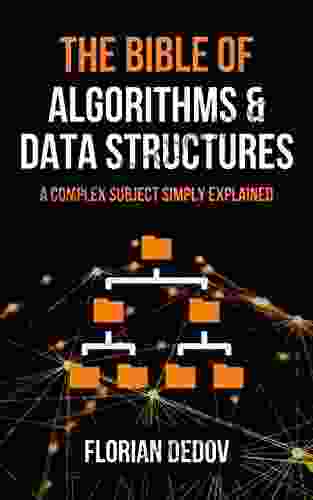Demystifying Runtime Complexity: A Comprehensive Guide to Big Notation for Programmers

4.3 out of 5
| Language | : | English |
| File size | : | 1626 KB |
| Text-to-Speech | : | Enabled |
| Screen Reader | : | Supported |
| Enhanced typesetting | : | Enabled |
| Print length | : | 112 pages |
| Lending | : | Enabled |
In the realm of computer science, understanding the efficiency of algorithms and programs is paramount. Runtime complexity plays a crucial role in this assessment, as it measures the amount of time and resources required for a particular algorithm to complete its task.
Big notation, a mathematical tool, provides a concise and standardized way to describe the runtime complexity of algorithms. It helps programmers analyze and compare the efficiency of different algorithms and make informed decisions about which one to use in a given situation.
Breaking Down Runtime Complexity
Runtime complexity, often referred to as time complexity, quantifies the time taken by an algorithm to execute as a function of the size of its input. It's typically expressed in terms of asymptotic notation, which describes the behavior of a function as its input grows very large.
The most common asymptotic notations are:
- O(1) - Constant Time: The algorithm's runtime remains constant regardless of the input size.
- O(log n) - Logarithmic Time: The algorithm's runtime grows logarithmically with the input size.
- O(n) - Linear Time: The algorithm's runtime grows linearly with the input size.
- O(n²) - Quadratic Time: The algorithm's runtime grows quadratically with the input size.
- O(2n) - Exponential Time: The algorithm's runtime grows exponentially with the input size.
Big Notation in Practice
Let's illustrate how big notation works with an example. Consider an algorithm that searches for an element in an array.
If the algorithm uses a linear search, it needs to check each element in the array one by one until it finds the target element. The runtime complexity of this algorithm is O(n),where n represents the number of elements in the array.
On the other hand, if the array is sorted and the algorithm uses binary search, it can divide the array in half at each step and discard half of the remaining elements. This reduces the search space by a factor of two with each iteration. The runtime complexity of binary search is O(log n).
Significance of Runtime Complexity
Understanding the runtime complexity of algorithms is essential for:
- Algorithm Selection: Choosing the most efficient algorithm for a given task.
- Performance Optimization: Identifying and improving performance bottlenecks in code.
- Scalability Planning: Estimating how a program will perform as the input size increases.
- Resource Allocation: Determining the appropriate hardware and software resources for a given application.
Mastering runtime complexity and big notation is a fundamental skill for programmers. By understanding these concepts, you can analyze the efficiency of algorithms, make informed decisions about their implementation, and optimize your code for better performance and scalability.
For a thorough and practical exploration of runtime complexity and big notation, I highly recommend the book "Complex Subject Simply Explained: Runtime Complexity, Big Notation, Programming" by me, a renowned expert in computer science.
This comprehensive guide delves into the intricacies of runtime complexity, providing clear explanations, real-world examples, and practical exercises to help you grasp these concepts and apply them effectively in your programming projects.
By investing in your understanding of runtime complexity, you empower yourself to become a more proficient and efficient programmer, unlocking the full potential of your software creations.
4.3 out of 5
| Language | : | English |
| File size | : | 1626 KB |
| Text-to-Speech | : | Enabled |
| Screen Reader | : | Supported |
| Enhanced typesetting | : | Enabled |
| Print length | : | 112 pages |
| Lending | : | Enabled |
Do you want to contribute by writing guest posts on this blog?
Please contact us and send us a resume of previous articles that you have written.
 Book
Book Novel
Novel Page
Page Chapter
Chapter Text
Text Story
Story Genre
Genre Reader
Reader Library
Library Paperback
Paperback E-book
E-book Magazine
Magazine Newspaper
Newspaper Paragraph
Paragraph Sentence
Sentence Bookmark
Bookmark Shelf
Shelf Glossary
Glossary Bibliography
Bibliography Foreword
Foreword Preface
Preface Synopsis
Synopsis Annotation
Annotation Footnote
Footnote Manuscript
Manuscript Scroll
Scroll Codex
Codex Tome
Tome Bestseller
Bestseller Classics
Classics Library card
Library card Narrative
Narrative Biography
Biography Autobiography
Autobiography Memoir
Memoir Reference
Reference Encyclopedia
Encyclopedia Francesca Corso
Francesca Corso William K Zimmer
William K Zimmer Elizabeth Cody Kimmel
Elizabeth Cody Kimmel Tameichi Hara
Tameichi Hara Matt Donley
Matt Donley S D Rowell
S D Rowell Michael Smith
Michael Smith Frankie Gaw
Frankie Gaw Mark Lewis
Mark Lewis Suzanne Leonhard
Suzanne Leonhard Frances Carpenter
Frances Carpenter Matt Forbeck
Matt Forbeck Steven Rogers
Steven Rogers Lawrence Raab
Lawrence Raab Frank Murphy
Frank Murphy Summer Flowers
Summer Flowers Genie Reads
Genie Reads Fred Anderson
Fred Anderson Frank Kennedy
Frank Kennedy Junichiro Tanaka
Junichiro Tanaka
Light bulbAdvertise smarter! Our strategic ad space ensures maximum exposure. Reserve your spot today!

 Jimmy ButlerBeautiful Questions, Finding Nature's Deep Design: Unlocking the Wonders of...
Jimmy ButlerBeautiful Questions, Finding Nature's Deep Design: Unlocking the Wonders of...
 Ronald SimmonsMore True Stories of a Country Nurse on a Scottish Isle: A Poetic Tapestry of...
Ronald SimmonsMore True Stories of a Country Nurse on a Scottish Isle: A Poetic Tapestry of... Victor HugoFollow ·11.1k
Victor HugoFollow ·11.1k John ParkerFollow ·9.8k
John ParkerFollow ·9.8k Maurice ParkerFollow ·9.4k
Maurice ParkerFollow ·9.4k David BaldacciFollow ·2.4k
David BaldacciFollow ·2.4k Franklin BellFollow ·5.4k
Franklin BellFollow ·5.4k Ian MitchellFollow ·3.2k
Ian MitchellFollow ·3.2k Nick TurnerFollow ·2.4k
Nick TurnerFollow ·2.4k Anthony WellsFollow ·3.3k
Anthony WellsFollow ·3.3k

 Howard Blair
Howard BlairHeroes and Villains from American History: The Biography...
David Dixon...

 Felipe Blair
Felipe BlairAn Informal History of the 1920s: Uncovering the Roaring...
The 1920s, an era...

 Howard Blair
Howard BlairHow a Peculiar Victorian Zookeeper Waged a Lonely Crusade...
In the enigmatic world of Victorian...

 Harold Powell
Harold PowellMemoir of Food, Wine, and Love in Italy: A Culinary...
Prepare your senses...
4.3 out of 5
| Language | : | English |
| File size | : | 1626 KB |
| Text-to-Speech | : | Enabled |
| Screen Reader | : | Supported |
| Enhanced typesetting | : | Enabled |
| Print length | : | 112 pages |
| Lending | : | Enabled |












